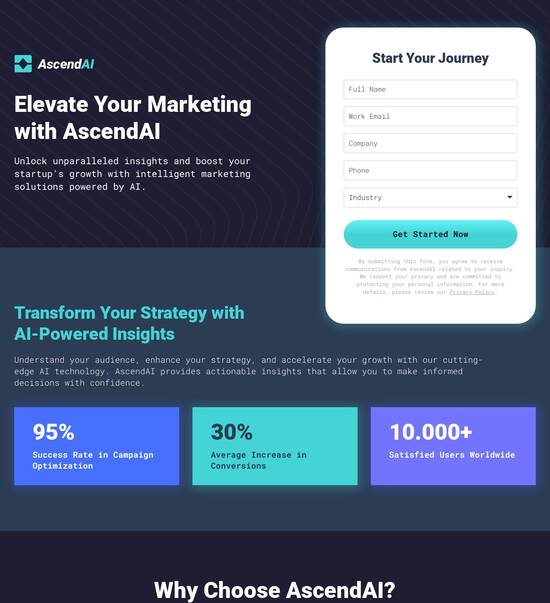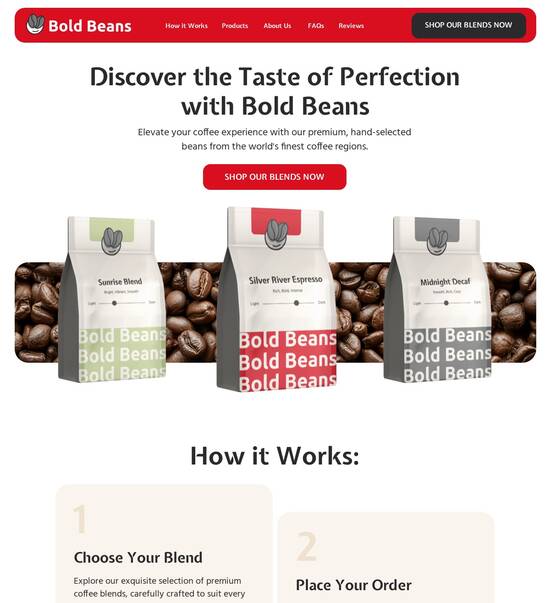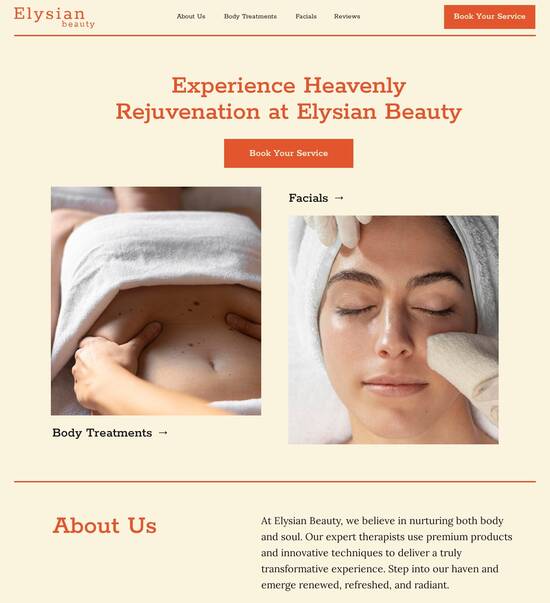
HTML page template for Philosophy teachers
Use TemplateAbout template
Attract clients and showcase your skills with style using our landing page templates for Philosophy teachers. Let's convert those visitors into clients!
Recommended templates

Easy to build without coding
With the intuitive drag-and-drop builder, anyone on your team can create high-converting pages without any knowledge of code or design. Make enhancements to your landing page with custom widgets using Javascript, HTML/CSS, or third-party scripts.

Multiple layouts for any industry and goal
Select from 500+ landing page layouts built to boost conversions across industry-specific scenarios. Customize them by adjusting fonts, adding images, and generating on-brand content with the AI assistant. Quickly scale with Instablocks® and Global Blocks that you can save, reuse, and update globally.

Loads fast and looks polished on any device
Every template is responsive, which means they present professionally on any device and load blazingly fast with our Thor Render Engine. You can also power them up with Google AMP technology to deliver an unparalleled mobile experience and drive higher conversions.

Robust analytics & experimentation
Get real-time updates and reporting across all your devices, showing the number of visitors, conversions, cost-per-visitor, and cost-per-lead. Launch AI-powered experiments, run A/B tests, and use heatmaps to analyze user behavior, then optimize your landing page to maximize conversions.







Easy to build without coding
With the intuitive drag-and-drop builder, anyone on your team can create high-converting pages without any knowledge of code or design. Make enhancements to your landing page with custom widgets using Javascript, HTML/CSS, or third-party scripts.
Multiple layouts for any industry and goal
Select from 500+ landing page layouts built to boost conversions across industry-specific scenarios. Customize them by adjusting fonts, adding images, and generating on-brand content with the AI assistant. Quickly scale with Instablocks® and Global Blocks that you can save, reuse, and update globally.
Loads fast and looks polished on any device
Every template is responsive, which means they present professionally on any device and load blazingly fast with our Thor Render Engine.
Robust analytics & experimentation
Get real-time updates and reporting across all your devices, showing the number of visitors, conversions, cost-per-visitor, and cost-per-lead. Launch AI-powered experiments, run A/B tests, and use heatmaps to analyze user behavior, then optimize your landing page to maximize conversions.
All the features you need to build lead-generating landing pages
Explore more featuresLearn how to build top-performing landing pages for any goal
FAQs
Leading the way in building high-performing landing pages





A step-by-step guide to optimizing your campaigns with Instapage
Optimizing digital marketing campaigns requires powerful tools that drive results efficiently. Instapage stands as the most powerful landing page and CRO platform designed to empower marketers. Whether in business services, tech, or education, harnessing the capabilities of Instapage can drastically enhance your marketing efficiency.
Understanding Instapage and its value proposition
Instapage provides a comprehensive platform that caters to various aspects of landing page creation, optimization, and collaboration. It simplifies the process of building high-converting landing pages with over 100 ready-made templates and lead generation elements.
- Templates: Over 100 high-converting templates designed to maximize your landing page performance.
- Heatmaps: Understand user interactions on your pages to refine designs and content.
- AB Testing: Conduct experiments to compare versions of pages for optimal conversion rates.
Step 1: Launching a landing page with Instapage
Getting started with Instapage is straightforward. To launch your first landing page, follow these steps:
- Choose a template: Select from the extensive library of templates tailored for your industry’s needs.
- Customize key elements: Use the intuitive drag-and-drop builder to modify text, images, and forms.
- Publish with ease: Quick publishing options allow you to go live fast, capturing leads immediately.
Step 2: Optimizing your landing pages
Once your landing page is live, the focus shifts to optimization. Utilize the following tools available in Instapage to increase conversions.
- Heatmap Analysis: Gain insights on where users click most often, enabling better design decisions.
- A/B Testing: Run experiments to test different headlines or layouts on your pages.
- Analytics Dashboards: Assess your campaigns' performance across multiple metrics and adjust accordingly.
Step 3: Collaborating for enhanced productivity
Collaboration is key to effective campaign management. Leverage Instapage's collaborative features to speed up feedback and improve the production process.
- Real-Time Edits: Make instantaneous modifications and see changes in real time.
- Feedback Mechanism: Share your pages securely with stakeholders and gather instant feedback.
- Team Collaboration: Work collectively with your marketing team to ensure alignment and efficiency.
By following these steps, your marketing team can effectively harness the full potential of Instapage.
Ready to transform your digital marketing efforts? Sign up for Instapage today and start building landing pages that convert.
HTML page template for philosophy teachers
Understanding the role of HTML page templates in philosophy education
The teaching landscape for philosophy is diverse, involving various pedagogical approaches that require adaptable tools and resources. Philosophy teachers often seek methods to engage students deeply with abstract concepts, encourage critical thinking, and facilitate discussions on complex ideas. Here, the role of HTML page templates becomes increasingly significant, as they allow educators to create tailored online environments that cater specifically to their teaching methodologies.
HTML page templates provide a foundational structure that educators can customize according to curriculum requirements, making philosophy content more accessible and engaging. By utilizing these templates, teachers can focus on developing course material rather than spending excessive time on web design. This leads to streamlined content delivery that resonates with students and enhances their learning experience.
Enhances engagement through visually appealing layouts.
Offers a framework for interactive tools that foster discussion.
Reduces time spent on technical aspects of webpage creation.
Key components of an effective HTML page template for philosophy teachers
When creating an HTML page template specifically for philosophy educators, several key components must be considered to ensure effectiveness. A user-friendly design is paramount, as it plays a crucial role in attracting student attention and maintaining usability. Aesthetically pleasing layouts not only create an inviting atmosphere but also encourage students to explore the content offered. Additionally, accessibility features must be incorporated to accommodate diverse learner needs, helping ensure all students can engage with philosophical material.
Moreover, responsive web design is vital for optimizing the viewing experience across various devices. As many students access educational content via smartphones and tablets, having a template that adjusts to different screen sizes ensures that learning is consistent and seamless, regardless of the device used. Adopting responsive design principles not only enhances user experience but also allows philosophy teachers to reach a broader audience.
Essential features of an HTML page template
To create a comprehensive learning environment, an HTML page template must incorporate essential features such as dynamic content integration. Utilizing JavaScript effectively can enhance interactivity on the webpage, allowing for the creation of reusable code blocks. For example, a simple JavaScript function can modify specific elements on the page based on student actions, helping create an engaging learning experience that encourages participation.
The concept of document ready events plays a crucial role in modern web development. The `document.addEventListener` method is particularly useful as it enables developers to define specific actions when certain events are triggered. In the context of philosophy education, these events can be used to initiate discussions or display relevant resources at key moments during a lesson, creating a structured yet flexible educational environment.
JavaScript functions enhance interactive content.
Document ready events improve page responsiveness and accessibility.
Dynamic content keeps students engaged with relevant information.
Customization potential for philosophy teachers
Customization is a critical aspect when creating HTML page templates for philosophy teachers. These educators can implement various themes and stylistic options that reflect different philosophical doctrines. For instance, templates could be designed around Nietzschean aesthetics or Socratic dialogue structures. Selecting appropriate color schemes and typography not only enhances the visual appeal but also aligns with the philosophical discourse being taught, making the learning process richer and more immersive.
Furthermore, customizing content sections to cater to specific curriculum needs allows for the inclusion of interactive forums or discussion boards where students can engage with each other. Multimedia elements such as videos, podcasts, and lecture notes are vital for accommodating various learning styles and complementing the textual content provided in the curriculum. Additionally, functional widgets for quizzes, polls, and feedback forms can help educators gauge student understanding and adapt teachings accordingly.
Implement philosophical themes in template design.
Embed multimedia to enhance diverse learning experiences.
Use functional widgets for student engagement and assessment.
Enhancing interactivity and engagement with JavaScript
Incorporating JavaScript into HTML templates significantly enhances interactivity and user engagement. For instance, teachers can design interactive case studies that utilize branching logic. This method allows students to navigate through philosophical dilemmas based on their responses, promoting critical thinking and deeper understanding of philosophical perspectives.
Moreover, JavaScript can be employed to create pop-up quotes from famous philosophers during lessons, inviting spontaneous class discussions. Such interactive elements not only provide a refreshing break from traditional teaching methods but also encourage students to appreciate the relevance of philosophical ideas in contemporary contexts. Utilizing scripts effectively helps foster a more engaging and lively classroom environment.
Create interactive case studies using branching logic.
Implement pop-up quotes for promoting class discussions.
Utilize scripts to enhance the overall user experience.
Assessing the benefits of template implementation
Implementing HTML page templates offers numerous benefits for philosophy teachers, starting with time efficiency. With pre-designed sections and customizable templates, educators can significantly streamline the content creation process. This reduction in repetitive coding allows them to focus on developing quality educational material and engaging with their students, thus enriching the learning experience.
Additionally, HTML templates can lead to increased student engagement by implementing strategies that captivate attention through thoughtful designs. Interactive elements, such as embedded quizzes and discussion boards, support greater participation and retention of philosophical concepts. Customizable templates also accommodate various educational goals, allowing teachers to adapt resources based on different philosophical themes and teaching methods, fostering collaborative learning environments.
Reduces time spent on design processes.
Increases student engagement with interactive elements.
Allows adaptation to diverse educational goals.
Case studies: Success stories from philosophy educators
Analyzing real-world implementations of HTML templates in philosophy education provides valuable insights into their effectiveness. Many university educators have adopted these templates to enhance their online courses, offering feedback on the impact these resources have on student engagement and learning outcomes. Success stories illustrate how innovative uses of these templates can foster enriched discussions and collaborative projects among students.
A comparative analysis reveals different approaches to web design and their respective educational outcomes. Some educators reported increased student focus and participation after switching to customized templates, while others encountered challenges during their initial integration phase. Identifying lessons learned from unsuccessful implementations can guide future improvements and better integration of HTML templates in philosophy teaching.
Showcase innovative uses in university settings.
Gather feedback on effectiveness from students and faculty.
Analyze challenges faced and lessons learned for future adaptations.
Future of HTML templates in philosophy teaching
Looking ahead, emerging trends and innovations will continue to shape the future of HTML templates in philosophy education. Anticipated advancements in web technology may introduce new features that enhance interactivity and accessibility, allowing for even more engaging learning experiences. Furthermore, as the education sector adapts to the growing reliance on digital platforms, the evolution of HTML templates will likely reflect these changes, catering specifically to the needs of philosophy educators.
Preparing for a digital classroom also means understanding how to effectively adapt philosophical discussions for online platforms. HTML templates can facilitate this process by providing the necessary structure and engagement tools to create impactful virtual learning environments. Teachers equipped with tailored templates will be better prepared to foster meaningful dialogue around philosophical ideas, ultimately enriching the educational experience for their students.
Anticipate advancements in web technology for education.
Understand the importance of adapting philosophical discourse for digital formats.
Utilize HTML templates to create effective virtual classrooms.
Final thoughts on the integrative power of HTML templates
Reflecting on the benefits that tailored HTML templates provide to philosophy educators illustrates their integral role in enhancing educational outcomes. These structured resources not only save time but also promote deeper engagement with philosophical material. Investing in thoughtfully designed templates can foster a collaborative, responsive learning environment that effectively supports both teaching and learning.
As philosophy continues to evolve in the digital landscape, utilizing HTML templates offers the opportunity to adapt curriculums to modern educational approaches. Ensuring that philosophical discussions and teachings remain relevant and engaging is crucial, and the right web solutions can significantly contribute towards achieving those goals.
Ready to skyrocket conversions?
Supercharge your ad campaigns with high-performing landing pages
Get started














